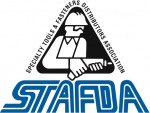STAFDA Inventory Consultant: Collaborative Planning
Harnessing the power of CPFR: Collaborative Planning, Forecasting and Replenishment
 |
 |
When you hear the term “business to business (B2B) E-commerce” what comes to mind? Buyers looking through on-line catalogs and placing orders for needed products? Companies sending purchase orders via EDI (electronic data interchange) that are automatically transformed into sales orders in their suppliers’ computer systems? Or, maybe the ability to pinpoint the exact position of a package
being shipped to you from a vendor?
There is another form of electronic commerce that promises to greatly increase the efficiency of the supply chain. It is called Collaborative Planning Forecasting &
Replenishment (CPFR). CPFR involves a customer
regularly notifying a supplier of his/her expected future needs of certain products. To see the value of CPFR, let’s look at an example:
Acme Manufacturing makes widgets. The number of widgets produced by Acme varies from 50 pieces to 1,000 per month depending on orders from its customers and forecasts from its sales force. Each widget requires two #B100 adapters which are normally purchased from Smith Distribution. Previously Acme used minimum and maximum
parameters to replenish their stock of the #B100 adapter:
Acme Manufacturing’s Minimum = 10 pieces
Acme Manufacturing’s Maximum = 110 pieces
When the on-hand quantity of the adapter fell below 10 pieces they would order a box of 100 adapters from Smith Distribution. Acme expects, and receives, same day delivery of the product.
Smith Distribution’s lead-time for the adapter is two weeks. Their buyer, Rick Sarner, previously based his replenishment decisions for the #B100 adapter on the usage history recorded for the item:
Smith Distribution’s Minimum = 200
Smith Distribution’s Maximum = 500
Rick thought that he was stocking the item conservatively by setting the minimum to 200 pieces or two of Acme’s normal orders. He was in shock when he was chastised in August (when Acme required 900 pieces) for running out of the product and shutting down his customer’s production line. To avoid future problems, Rick’s first reaction was to significantly increase his minimum and maximum stock quantities. But, he found there were two problems with this solution:
1) How large should he set the minimum and maximum quantities? Unless Rick based the replenishment parameters based on Acme’s capacity to produce the product, he will always run the risk of a stock out.
2) Because a large quantity isn’t delivered to the customer every month, greatly increasing the minimum and maximum quantities would have a detrimental effect on Smith Distribution’s inventory turnover and therefore, its profitability.
Rick determined that his stocking problems were the result of a lack of information. He was always forced to guess, based on past history or informal comments from his salespeople, his customer’s future demand of the product.
Collaborative Planning and Forecasting Requirements (CPFR) presents a better solution by facilitating communication between Smith Distribution and Acme Manufacturing. Acme doesn’t wait until there are 10 pieces left on the shelf to call Smith and order another box of the product. Acme electronically communicates changes in its future needs for the
#B100 adapter to Smith Distribution based on its widget production schedule:

Rick can base his purchases on what Acme expects to use in the future, not what they have used in the past. Changes in Acme’s production schedule and the need of the #B100 adapter are electronically communicated to Smith Distribution.
If Acme plans to increase production from 50 to 100 widgets during the week of October 23rd, it sends an electronic notice of the change to Smith Distribution’s computer system. As a result, Rick will have ample time to get the necessary stock from the vendor. On the other hand, if Acme decides to decrease widget production, Rick can reduce his stocking levels.
Of course, Rick is not about to bet his job on the accuracy of Smith’s forecast. He will retain a safety stock of 200 pieces to protect customer service just in case Acme has an unexpected emergency order from one of its customers, or a replenishment shipment from the vendor is delayed. In fact, Smith distribution will carefully monitor the accuracy of Acme’s predictions of future product usage:

Because Acme’s forecasts of future usage are very accurate, Rick can order the #B100 adapter to meet Acme’s expected usage. The result: Smith Distribution can stock less of the product and still maintain a high level of customer service. In fact, they probably can reduce the 200 piece safety stock quantity.
As an incentive to keep providing accurate forecasts, Smith Distribution bases Acme’s discount for adapters, in part, on the accuracy of its product forecast. Smith Distribution can maintain less inventory. Acme gets the #B100 adapter at a lower price. Rick Sarner has fewer sleepless nights worrying about how much of the product to stock. CPFR truly provides a win-win-win situation.
Even if your computer system does not currently support CPFR, you can institute a collaborative forecasting program:
1) Ask your good customers for product usage forecasts. Not every customer can provide this type of information, but offer an incentive to those that can provide accurate future usage information (e.g. actual purchases within 20% or 25% of their forecast).
2) Make sure that shipments to customers providing forecasts are not included in your normal usage history. After all, you may sell these products to other customers too. Your total forecast demand quantity will be the sum of collaborative forecasts and a factor of past usage. If you add usage that is included in collaborative forecasts to usage history, you will be “double counting” these sales in determining much to buy from the vendor.
3) Encourage your salespeople to offer collaborative forecast programs to your best customers, especially original equipment manufacturers (OEM) companies.
4) If you can determine, in advance, what you will need from your vendors, work
with them to develop a collaborative forecasting program in which you provide accurate estimates of your future needs in exchange for better terms or discounts.
Collaborative forecasting works to solve two of the greatest challenges faced by buyers and inventory managers:
- Stock outs of critical products
- Unneeded safety stock sitting on the shelf gathering dust
Of course there are many instances in which customers cannot predict there future product needs, but whenever they can collaborative forecasting promises to increase productivity and profitability throughout the supply chain. Let’s work to replace inventory with information. CS
Jon Schreibfeder is president of Effective Inventory Management, Inc. He has authored numerous articles and several books on inventory management best practices and is the designated inventory management consultant for STAFDA. Jon can be reached at 972-304-3325 or by e-mail at info@effectiveinventory.com















